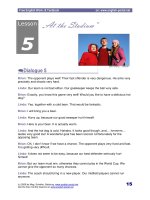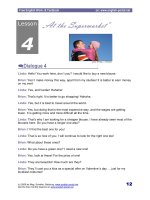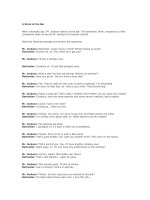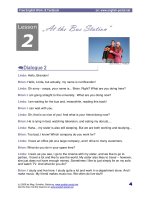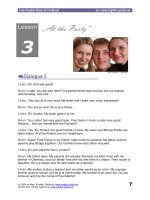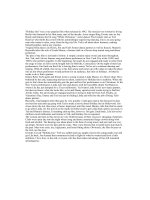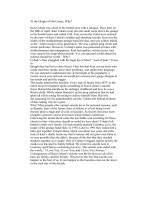casey at the bat
Bạn đang xem bản rút gọn của tài liệu. Xem và tải ngay bản đầy đủ của tài liệu tại đây (2.56 MB, 27 trang )
casey at the bat
“They thought, if only Casey could get but a whack at that—
We’d put up even money, now, with Casey at the bat.”
Couplet
Poem written by Ernest Thayer
Triplet
Lines
Verse
Quatrain
Baseball and poetry!
Did you see that
coming?
Table of Contents
Casey at the Bat
Casey at the Bat Poem
The History of Baseball
Parts of Poetry
Types of Poetry
Narrative Poems
Alliteration in Poetry *
Rhythm in Poetry
Write a Team Song
The Basics of Baseball *
Baseball Lingo
Descriptive Baseball Language
Casey Baseball Card
Write an Article
Write a New Ending
Act It Out: Casey at the Bat
Certificate of Completion
Answer Sheets
* Has an Answer Sheet
Want more workbooks? Join Education.com Plus to save time and money.
/>Copyright © 2014 Education.com. All Rights Reserved
Casey at the Bat
By Ernest Thayer
"Casey at the Bat" is a poem written by Ernest Thayer in 1888. Read the poem all the way through, then go
back and answer the questions for each stanza.
The outlook wasn't brilliant for the Mudville nine that day:
The score stood four to two, with but one inning more to play.
And then when Cooney died at first, and Barrows did the same,
A sickly silence fell upon the patrons of the game.
A straggling few got up to go in deep despair. The rest
Clung to that hope which springs eternal in the human breast;
They thought, if only Casey could get but a whack at that We'd put up even money, now, with Casey at the bat.
But Flynn preceded Casey, as did also Jimmy Blake,
And the former was a lulu and the latter was a cake;
So upon that stricken multitude grim melancholy sat,
For there seemed but little chance of Casey's getting to the bat.
But Flynn let drive a single, to the wonderment of all,
And Blake, the much despis-ed, tore the cover off the ball;
And when the dust had lifted, and the men saw what had occurred,
There was Jimmy safe at second and Flynn a-hugging third.
...
1. What does the narrator mean
when he says Cooney “died at
first”?
a. He died.
b. He was tagged out.
c. He walked off the field.
2. Why do you think the fans
began to leave?
a. They were hungry and went to the
snack bar.
b. The team was not playing well and
they were sure they would lose.
c. It was getting close to dinnertime
and they all went home to eat.
3. What do you think preceded
means?
a. Went after.
b. Went last.
c. Went before.
4. What’s a lulu?
a. A great player.
b. A snappy dresser.
c. A word we don’t use anymore.
5. To “drive a single” means:
a. To make it to first base.
b. To drive a car.
c. To take one step.
6. What does the narrator mean
when he says Blake “tore the
cover off the ball”?
a. He ripped the ball apart with his
hands.
b. He hit the ball so hard, the fabric
tore.
c. He missed the ball and when it fell,
the fabric ripped.
Copyright © 2014 Education.com LLC All Rights Reserved
More worksheets at www.education.com/worksheets
Casey at the Bat
By Ernest Thayer
Then from 5,000 throats and more there rose a lusty yell;
It rumbled through the valley, it rattled in the dell;
It knocked upon the mountain and recoiled upon the flat,
For Casey, mighty Casey, was advancing to the bat.
There was ease in Casey's manner as he stepped into his place;
There was pride in Casey's bearing and a smile on Casey's face.
And when, responding to the cheers, he lightly doffed his hat,
No stranger in the crowd could doubt 'twas Casey at the bat.
7. The poem says the fans’ cheers
“rumbled through the valley”
and “knocked upon the
mountain.” Why did he
describe it this way?
a. The fans were very loud.
b. The sound really did hit a mountain.
c. Their cheers were quiet.
Ten thousand eyes were on him as he rubbed his hands with dirt;
Five thousand tongues applauded when he wiped them on his shirt.
Then while the writhing pitcher ground the ball into his hip,
Defiance gleamed in Casey's eye, a sneer curled Casey's lip.
8. “There was ease in Casey's
manner as he stepped into his
place.” What does this tell you
about Casey?
a. He is a very shy person.
b. He is about 30 years old.
c. He is very proud and sure of himself.
And now the leather-covered sphere came hurtling through the air,
And Casey stood a-watching it in haughty grandeur there.
Close by the sturdy batsman the ball unheeded sped"That ain't my style," said Casey. "Strike one," the umpire said.
9. How do you pronounce
writhing?
a. woo-ree-thing
b. ry-thing
c. ree-thing
From the benches, black with people, there went up a muffled roar,
Like the beating of the storm-waves on a stern and distant shore.
"Kill him! Kill the umpire!" shouted someone on the stand;
And it’s likely they'd a-killed him had not Casey raised his hand.
10. What do you think defiance
is?
a. The act of wanting something.
b. Defying, or going against, the rules.
c. Asking for help.
11. What’s “the leather-covered
sphere”?
a. The bat.
b. The pitcher’s mound.
c. The ball.
12. Why is the crowd so angry?
a. The stadium ran out of hot dogs.
b. The umpire made a mistake.
c. They can’t believe Casey missed the
ball and are blaming it on the
umpire.
Copyright © 2014 Education.com LLC All Rights Reserved
More worksheets at www.education.com/worksheets
Casey at the Bat
By Ernest Thayer
With a smile of Christian charity great Casey's visage shone;
He stilled the rising tumult; he bade the game go on;
He signaled to the pitcher, and once more the spheroid flew;
But Casey still ignored it, and the umpire said, "Strike two."
13. Define tumult:
a. A loud noise from a crowd.
b. A wave.
c. A kind of fog.
14. How do you pronounce
"Fraud!" cried the maddened thousands, and echo answered fraud;
But one scornful look from Casey and the audience was awed.
They saw his face grow stern and cold, they saw his muscles strain,
And they knew that Casey wouldn't let that ball go by again.
The sneer is gone from Casey's lip, his teeth are clenched in hate;
He pounds with cruel violence his bat upon the plate.
And now the pitcher holds the ball, and now he lets it go,
And now the air is shattered by the force of Casey's blow.
Oh, somewhere in this favored land the sun is shining bright;
... and somewhere hearts are light,
The band is playing somewhere,
And somewhere men are laughing, and somewhere children shout;
But there is no joy in Mudville - mighty Casey has struck out.
fraud?
a. Frowd.
b. Frod.
c. Frood.
15. Why does the narrator say
the echo “answered” the
crowd?
a. Echoes sound like answers.
b. Someone came in late.
c. The crowd was asking a question.
16. What happened in the last
sentence?
a. Casey swung the bat.
b. Casey hit the ball.
c. Casey missed the ball.
17. Why is there a band playing
and people laughing?
a. Their team won.
b. They were celebrating Mudville’s
loss.
c. The game was held on the same day
as a parade.
ANSWERS: 1. b 2. b 3. c 4. c 5. a 6. b 7. a 8. c 9. b 10. b 11. c 12. c 13. a 14. b 15. a 16. a 17. a
Copyright © 2014 Education.com LLC All Rights Reserved
More worksheets at www.education.com/worksheets
The History of Baseball
Baseball wasn’t invented by one person; it grew out of popular games that immigrants brought to America
from Europe. Most people agree that it is most similar to a game from England called Rounders, but it also
contains elements of “stick and ball” games from countries like Russia, Germany, and France. Baseball was
easy for almost anyone to play—you didn’t have to be especially strong, tall, or clever to play the game well.
The first official team to play the game with the rules we use today were the New York Knickerbockers
(NICK-er-bock-ers) in 1845. In the next few years, a baseball craze swept New York City. Players in the area
began to form clubs and teams. Stadiums began being built so fans could watch their favorite teams play.
When “Casey at the Bat” was published in 1888, professional baseball had just been born. The National
League was established in 1876, and fans across the country were starting to spend their free time watching
their favorite teams play each other in stadiums.
1. Name three countries that baseball came from.
2. What was the name of the first team to play baseball by the rules we use today?
3. When was “Casey at the Bat” first published?
4. Why was baseball so popular?
5. It’s 1880 and you’ve just heard that a professional baseball team is starting in your town. Would you
want to be on the team or watch the games as a fan? Write three sentences that explain your answer below.
ANSWERS: 1. England, Russia, Germany, France 2. The New York Knickerbockers 3. 1888 4. It was easy for all kinds of people to play. 5. Answers will vary.
Copyright © 2014 Education.com LLC All Rights Reserved
More worksheets at www.education.com/worksheets
Parts of Poetry
The outlook wasn't brilliant for the Mudville nine that day:
The score stood four to two, with but one inning more to play.
And then when Cooney died at first, and Barrows did the same,
A sickly silence fell upon the patrons of the game.
A straggling few got up to go in deep despair. The rest
Clung to that hope which springs eternal in the human breast;
They thought, if only Casey could get but a whack at that We'd put up even money, now, with Casey at the bat.
Line: A line of words within a stanza.
Stanza/Verse: A group of lines within a poem, separated by spaces. A stanza is like a paragraph: It helps
organize the ideas in the poem.
Couplet: Two lines in a poem that go together. They usually rhyme with each other.
Triplet: A group of three lines that go together.
Quatrain: A group of four lines that go together. They usually rhyme in a pattern.
Voice: The unique way in which the poem is written. A poem’s voice can sound sad, happy, silly, or any other
feeling the reader gets while reading the poem.
1. Is “Casey at the Bat” written in couplets, triplets, or quatrains?
____________________________________________________________________________
2. How would you describe the poem’s voice?
____________________________________________________________________________
3. Write out the third line of the first stanza in “Casey at the Bat.”
____________________________________________________________________________
ANSWERS: 1. Quatrains 2. Answers will vary 3. And then when Cooney died at first, and Barrows did the same
Copyright © 2014 Education.com LLC All Rights Reserved
More worksheets at www.education.com/worksheets
Types of Poetry
Poetry can be written in many different ways. Read about a few different kinds of poetry, then give each
one a try!
Haiku: A haiku has three lines. The first one is five syllables long, the second is seven, and the third is five.
Haikus do not rhyme.
Walking on the beach
The waves crash on the seashore
The sound brings me peace.
Write a haiku about the events that take place in “Casey at the Bat.”
Diamante: Diamante poems are seven lines long. Starting with one word, the first four lines increase by one
word each, and the last three decrease by one. When they are written, they form a diamond shape. Diamante
poems often use adjectives and verbs to describe a noun.
Books
Dusty, musty
Exciting, inviting, intriguing
Fairytales, fables, mysteries, adventures
Quiet, Silent, Solitary
Words, pages
Reading.
Write a diamante poem about your favorite sport.
Copyright © 2014 Education.com LLC All Rights Reserved
More worksheets at www.education.com/worksheets
Types of Poetry
Acrostic: In an acrostic poem, each line begins with the letter in a noun. When finished, the first letter of
every line will spell out a word. Each line of the poem describes the noun.
Sometimes sunny skies
Puddles on the ground
Rainbows and flowers
Into a new season
New life all around
Great time to be outdoors.
Write an acrostic poem about Casey.
C
A
S
E
Y
Cinquain: Cinquain poems are similar to diamante poems. Cinquains are five lines long. They have two
syllables in the first line, four in the second, six in the third, eight in the fourth, and two in the last. It is common
for a cinquain poem to describe a noun, with a noun as the first line, adjectives to describe it as the second,
third, and fourth, and a synonym for the noun as the last.
Raindrops
Dripping, dropping
Splashing, tinkling, sprinkling
Lightly falling from the gray sky
Showers.
Write a cinquain poem about the game of baseball.
Copyright © 2014 Education.com LLC All Rights Reserved
More worksheets at www.education.com/worksheets
Narrative Poems
“Casey at the Bat” is a narrative poem. Narrative poems are poems that tell stories. Just like a
story, narrative poems have a beginning, a middle, and an end. Some famous narrative poems
are “Paul Revere’s Ride” by Henry Wadsworth Longfellow, “The Walrus and the Carpenter”
by Lewis Carroll, and “The Raven” by Edgar Allan Poe.
Read the narrative poem below.
Rotten, Icky Monday Mornings by Alison Roozeboom
Those rotten, icky Monday mornings
always get my goat.
This morning I woke up and had
an itchy, scratchy throat,
I burnt my tongue on hot cocoa,
then tripped down half the stairs,
forgot my lunch, forgot my books,
forgot to brush my hair.
At recess Billy said to me,
“Ha-ha, you’re such a nerd!”
I was so upset that during class
I didn’t hear a word,
and when the teacher called on me
I had nothing to say.
When class was done, Miss Johnson came
to me and asked, “Bad day?”
I nodded, so she smiled and said,
“I thought that you seemed blue—
those rotten, icky Monday mornings
get me sometimes, too.
I’ll tell you what I do to turn
a nasty day around:
First, I jump a dozen times
just one foot on the ground.
I scrunch my nose and purse my lips
and shut my eyes so tight,
I flap my arms like chicken wings
and roar with all my might.”
And sure enough, the silly jig
was like a magic cure.
I did it all the way back home
and I can say for sure,
those rotten, icky Monday mornings
may be quite a pain,
but laughing makes it easier
to pick yourself up again.
Write a narrative poem about your day so far. It doesn’t have to rhyme!
Copyright © 2014 Education.com LLC All Rights Reserved
More worksheets at www.education.com/worksheets
Alliteration
Alliteration happens when two or more words in a sentence or phrase have the same beginning sound.
She sells seashells by the seashore.
Peter Piper picked a peck of pickled peppers.
Jody just loves to go jogging with giraffes.
“Casey at the Bat” contains lots of alliteration. Circle or underline the alliterative words in
each line of these stanzas. Use different colors for different beginning sounds. The first one
has been done for you.
The outlook wasn't brilliant for the Mudville nine that day:
The score stood four to two, with but one inning more to play.
And then when Cooney died at first, and Barrows did the same,
A sickly silence fell upon the patrons of the game.
…
But Flynn preceded Casey, as did also Jimmy Blake,
And the former was a lulu and the latter was a cake;
So upon that stricken multitude grim melancholy sat,
For there seemed but little chance of Casey's getting to the bat.
…
Then from 5,000 throats and more there rose a lusty yell;
It rumbled through the valley, it rattled in the dell;
It knocked upon the mountain and recoiled upon the flat,
For Casey, mighty Casey, was advancing to the bat.
…
Oh, somewhere in this favored land the sun is shining bright;
The band is playing somewhere, and somewhere hearts are light,
And somewhere men are laughing, and somewhere children shout;
But there is no joy in Mudville - mighty Casey has struck out.
Copyright © 2014 Education.com LLC All Rights Reserved
More worksheets at www.education.com/worksheets
Rhythm in Poetry
Rhythm can change the mood of a poem. Think about the way sports announcers speak: They usually start
talking faster and louder when something exciting happens in the game.
Clap along to the beat of the beginning, middle, and ending stanzas of the poem.
1
The outlook wasn't brilliant for the Mudville nine that day:
The score stood four to two, with but one inning more to play.
And then when Cooney died at first, and Barrows did the same,
A sickly silence fell upon the patrons of the game.
Did this stanza make you feel:
a. sad b. happy c. scared d. other:
2
But Flynn let drive a single, to the wonderment of all,
And Blake, the much despis-ed, tore the cover off the ball;
And when the dust had lifted, and the men saw what had occurred,
There was Jimmy safe at second and Flynn a-hugging third.
3
Then from 5,000 throats and more there rose a lusty yell;
It rumbled through the valley, it rattled in the dell;
It knocked upon the mountain and recoiled upon the flat,
For Casey, mighty Casey, was advancing to the bat.
Did your rhythm change from the second to third stanzas? How?
4
Oh, somewhere in this favored land the sun is shining bright;
The band is playing somewhere, and somewhere hearts are light,
And somewhere men are laughing, and somewhere children shout;
But there is no joy in Mudville - mighty Casey has struck out.
What is happening in this stanza?
How does this stanza feel different from the first three?
Chances are, you wanted to clap a little faster along 2 and 3 stanzas. How does a faster rhythm make you feel?
Copyright © 2014 Education.com LLC All Rights Reserved
More worksheets at www.education.com/worksheets
Write a Song
Lots of teams have songs that their fans sing to support them during games. Make one up for the Mudville
team, using what you know about the team from the poem. Write it in rhyming couplets or quatrains.
Example: “Take Me Out to the Ballgame” is a song that’s traditionally sung at baseball games. Did you know
it has two other verses?
Katie Casey was baseball mad,
Had the fever and had it bad.
Just to root for the home town crew,
Ev'ry sou 1
Katie blew.
On a Saturday her young beau 2
Called to see if she'd like to go
To see a show, but Miss Kate said "No,
I'll tell you what you can do:"
1
2
sou: cent.
beau: boyfriend
CHORUS (“Take me out to the ballgame…”)
Katie Casey saw all the games,
Knew the players by their first names.
Told the umpire he was wrong,
All along,
Good and strong.
When the score was just two to two,
Katie Casey knew what to do,
Just to cheer up the boys she knew,
She made the gang sing this song:
BONUS: Circle all the couplets in “Take Me Out to the Ballgame.”
Copyright © 2014 Education.com LLC All Rights Reserved
More worksheets at www.education.com/worksheets
The Basics of Baseball
To play baseball, you need two teams of nine players. The object of the game is to score more runs than the
other team. To score a run, a player must hit the ball, run all the bases, and make it back to home plate.
Baseball is played on a field. A baseball field has an infield and an outfield. The infield has four bases: first,
second, third, and home plate. In the middle of the infield is the pitcher’s mound, where the pitcher stands
when he throws the ball. The catcher squats behind the batter, who hits the ball with a bat from home plate.
The umpire, who does not play for either team, makes sure that the game is played fairly.
Center Field
Right Field
Left Field
Second Base
Third Base
First Base
Pitcher’s Mound
Home Plate
Players take turns trying to hit the ball. If the batter can’t hit the ball after three swings he’s out, and the next
player goes up to bat. When a batter swings but doesn’t hit the ball, it’s called a strike.
If the batter hits the ball, he or she runs to first base. When the next batter hits the ball, the first batter runs to
second while the one that was just batting runs to first. If a player from the other team catches the ball while
it’s in the air, the batter is out.
If the ball is in the air, players in the field try to catch it. If the ball has hit the ground, the fielder (a person
playing in the field) must either throw it to a baseman (a fielder standing at a base) or run to the base before
the runner gets there. If the baseman catches the ball before the runner gets to the base, the runner is out. After
three outs, the teams switch places, and the team that was up to bat takes the field.
A game of baseball is split up into innings, which end when both teams have taken their turns playing in the
field and going to bat. Innings are played nonstop for seven or nine innings. The team with the most runs at
the end of those innings wins.
VOCABULARY Define these terms:
run:
umpire:
strike:
fielder:
baseman:
inning:
Q&A
1. What happens when a batter misses the ball three times in a row?
2. How does a player score a run?
Copyright © 2014 Education.com LLC All Rights Reserved
More worksheets at www.education.com/worksheets
Baseball Lingo
Baseball has its own special language—“line drive,” “home run,” and “strike out” are all phrases that come
from the game of baseball, and “Casey at the Bat” is full of baseball words.
Here are some modern-day baseball words and phrases. Can you match the definitions to the words? Use
context clues to help you.
1. bag
a. A left-handed pitcher.
2. bases loaded
3. dish
b. Two games played between the same teams, on
the same day, in front of the same crowd.
c. A base.
4. double header
d. When there are runners on all three bases.
5. gap
6. grand slam
e. A home run that’s hit while there are runners on
all three bases.
f. The pitcher’s mound.
7. hill
g. The area of the outfield between the outfielders.
8. homer
h. Home plate.
9. shoestring catch
i. A home run.
10. southpaw
j. A catch made just before the ball hits the ground.
ANSWERS: 1. c 2. d 3. g 4. b 5. g 6. e 7. f 8. i 9. j 10. a
Copyright © 2014 Education.com LLC All Rights Reserved
More worksheets at www.education.com/worksheets
Descriptive Language
How boring would it be if sports announcers shouted things like, “He hit the ball!"? Rewrite
these events in more exciting language. Use some of the words and phrases from the previous
pages, or feel free to make up your own!
The out-of-town team scores.
_________________________________________________________________________!
After his team has been lagging behind, a batter hits a home run that ties the game.
_________________________________________________________________________!
The pitcher hits the batter with the ball.
_________________________________________________________________________!
A fielder drops a ball that was in the air.
_________________________________________________________________________!
A fan runs out on the field during the game!
_________________________________________________________________________!
WOW! THAT WAS A REAL HUMDINGER, FOLKS!
Copyright © 2014 Education.com LLC All Rights Reserved
More worksheets at www.education.com/worksheets
Baseball Card
Who is Casey? Some say he’s a hero, others think he’s full of himself. What do you think about him?
Make a baseball card for the star of the poem.
asey here.
cture of C
Draw a pi
Name:
Nicknam
e:
Birthda
y:
Height:
Weight
:
Likes:
Dislikes
:
Persona
lity Tr
aits:
Copyright © 2014 Education.com LLC All Rights Reserved
More worksheets at www.education.com/worksheets
Write an Article
Pretend you’re a sports reporter covering the game that day. How would you summarize
the game? Write a review of the game and draw a picture to go along with it.
THE MUDVILLE MESSENGER
Copyright © 2014 Education.com LLC All Rights Reserved
More worksheets at www.education.com/worksheets
Write a New Ending
“Casey at the Bat” has a great plot twist! How would the story be different if Casey hadn’t struck out?
Write a new ending to the poem and see how the mood changes. Remember to use the same rhythm
and rhyme pattern.
The sneer is gone from Casey's lip, his teeth are clenched in hate;
He pounds with cruel violence his bat upon the plate.
And now the pitcher holds the ball, and now he lets it go,
And now the air is shattered by the force of Casey's blow…
Copyright © 2014 Education.com LLC All Rights Reserved
More worksheets at www.education.com/worksheets
Act it Out:
“Casey at the Bat”
There’s so much drama in “Casey at the Bat.” Acting out the poem is a great way to better understand the
poem’s characters and plot. Grab some friends or classmates and put on a show!
Before you start, you may want to set up a small baseball diamond. Use pillows, books, pieces of cardboard,
or anything you have on hand as bases. Borrow some baseball caps, gloves, and jerseys for costumes. If you’re
outdoors, you can play the game along with the poem.
CAST OF CHARACTERS:
COONEY
BARROWS
FLYNN
BLAKE
PITCHER
UMPIRE
NARRATOR
CROWD
CASEY
(Tip: If there are a lot of kids, try breaking up the Narrator’s lines between a few people.)
CASEY AT THE BAT: A Reader’s Theater Script
SETTING: Mudville, USA, 1888.
(CROWD cheers)
NARRATOR:
The outlook wasn't brilliant for the Mudville nine that day:
The score stood four to two, with but one inning more to play.
And then when Cooney died at first, and Barrows did the same,
(COONEY and BARROWS run to first base, then leave)
A sickly silence fell upon the patrons of the game.
(CROWD goes quiet)
NARRATOR:
A straggling few got up to go in deep despair. The rest
(Some of the CROWD leaves)
Clung to that hope which springs eternal in the human breast;
They thought
Copyright © 2014 Education.com LLC All Rights Reserved
More worksheets at www.education.com/worksheets
Act it Out:
“Casey at the Bat”
CROWD:
If only Casey could get but a whack at that We'd put up even money, now, with Casey at the bat.
NARRATOR:
But Flynn preceded Casey, as did also Jimmy Blake,
(FLYNN and BLAKE go up to bat)
And the former was a lulu and the latter was a cake;
So upon that stricken multitude grim melancholy sat,
For there seemed but little chance of Casey's getting to the bat.
NARRATOR:
But Flynn let drive a single, to the wonderment of all,
(FLYNN runs to first base)
And Blake, the much despis-ed, tore the cover off the ball;
(BLAKE swings hard)
And when the dust had lifted, and the men saw what had occurred,
There was Jimmy safe at second and Flynn a-hugging third.
(FLYNN runs to third base, BLAKE runs to second)
NARRATOR:
Then from 5,000 throats and more there rose a lusty yell;
(CROWD cheers loudly!)
It rumbled through the valley, it rattled in the dell;
It knocked upon the mountain and recoiled upon the flat,
For Casey, mighty Casey, was advancing to the bat.
(CASEY steps up to bat)
NARRATOR:
There was ease in Casey's manner as he stepped into his place;
There was pride in Casey's bearing and a smile on Casey's face.
And when, responding to the cheers, he lightly doffed his hat,
(CASEY takes off his hat)
Copyright © 2014 Education.com LLC All Rights Reserved
More worksheets at www.education.com/worksheets
Act it Out:
“Casey at the Bat”
No stranger in the crowd could doubt 'twas Casey at the bat.
NARRATOR:
Ten thousand eyes were on him as he rubbed his hands with dirt;
(CASEY leans down and pretends to rub dirt on his hands)
Five thousand tongues applauded when he wiped them on his shirt.
(CASEY wipes his hands on his shirt)
Then while the writhing pitcher ground the ball into his hip,
(PITCHER pretends to hold the ball to his hip)
Defiance gleamed in Casey's eye, a sneer curled Casey's lip.
NARRATOR:
And now the leather-covered sphere came hurtling through the air,
(PITCHER pretends to throw the ball)
And Casey stood a-watching it in haughty grandeur there.
Close by the sturdy batsman the ball unheeded spedCASEY:
That ain't my style
NARRATOR:
said Casey
UMPIRE:
Strike one!
NARRATOR:
the umpire said.
NARRATOR:
From the benches, black with people, there went up a muffled roar,
Like the beating of the storm-waves on a stern and distant shore.
CROWD:
Kill him! Kill the umpire!
Copyright © 2014 Education.com LLC All Rights Reserved
More worksheets at www.education.com/worksheets
Act it Out:
“Casey at the Bat”
NARRATOR:
shouted someone on the stand;
And it’s likely they'd a-killed him had not Casey raised his hand.
(CASEY raises his hand)
NARRATOR:
With a smile of Christian charity great Casey's visage shone;
He stilled the rising tumult; he bade the game go on;
He signaled to the pitcher, and once more the spheroid flew;
But Casey still ignored it, and the umpire said
UMPIRE:
Strike two!
CROWD:
Fraud!
NARRATOR:
Cried the maddened thousands, and echo answered fraud;
But one scornful look from Casey and the audience was awed.
They saw his face grow stern and cold, they saw his muscles strain,
And they knew that Casey wouldn't let that ball go by again.
NARRATOR:
The sneer is gone from Casey's lip, his teeth are clenched in hate;
He pounds with cruel violence his bat upon the plate.
(CASEY pounds the bat on the ground)
And now the pitcher holds the ball, and now he lets it go,
(PITCHER throws the ball)
And now the air is shattered by the force of Casey's blow.
(CASEY swings. ALL freeze in place except the narrator)
NARRATOR:
Oh, somewhere in this favored land the sun is shining bright;
The band is playing somewhere, and somewhere hearts are light,
And somewhere men are laughing, and somewhere children shout;
But there is no joy in Mudville - mighty Casey has struck out.
Copyright © 2014 Education.com LLC All Rights Reserved
More worksheets at www.education.com/worksheets
Great job!
is an Education.com reading superstar
Answer Sheets
Casey at the Bat
Alliteration in Poetry
The Basics of Baseball
Want more workbooks? Join Education.com Plus to save time and money.
/>Copyright © 2014 Education.com. All Rights Reserved

